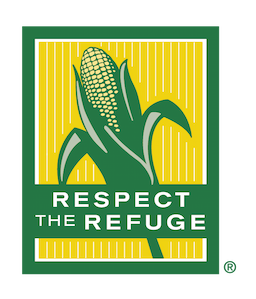Corn Leaf Aphid
December 10, 2018

If not controlled, corn leaf aphids can be a significant concern for farmers to manage and protect their investment and yield potential. Typically appearing in mid-June or early July, corn leaf aphids do not thrive in cold weather. They migrate annually from southern areas to the north, landing in mid- and upper-Midwest states. In favorable weather, corn leaf aphids may overwinter in lower Midwest states.
Identification and lifecycle
About the size of a pinhead, adult females are plump, round insects that look blue to gray in color. They have spikes rising from the top rear of their abdomen. Most corn leaf aphids don’t have wings, but in high populations, they may develop almost transparent wings, allowing them to fly onto other plants and create new aphid colonies.
Unlike most insects, the female corn leaf aphid doesn’t reproduce by laying eggs. Instead, they reproduce by giving birth to offspring called nymphs. These nymphs are sexually immature yet are capable of feeding on crops. An adult corn leaf female aphid can produce nine generations per season.
Adults and nymphs usually cluster in the whorls or higher up in the corn plant. The insect pest can thrive in grassy weeds that are left uncontrolled in corn fields.
Crop damage
The corn leaf aphid causes damage by sucking sap from corn plants. As part of the insect intrusion, it creates “honeydew,” which leaves a sticky deposit that causes mold. The result can look like black soot on the tops of corn plants.
Discolored patches show up in fields with heavy infestations of corn leaf aphids, causing corn leaves to curl, wilt and yellow. Deposits of the corn leaf aphid honeydew may cover silks and tassels, which disrupt the corn pollination process. Heavy feeding by aphids prior to tasseling leads to ears without grain or kernels that don’t properly develop.
According to Penn State University, it is believed that 30 to 40 percent of corn stalks heavily infested by corn leaf aphid will be barren.
Scouting
It’s important to scout for corn leaf aphids before tasseling, ideally three weeks ahead, according to Iowa State University.
When scouting fields, start at a different point each week. Walk a random pattern chosen in advance. Don’t consciously pick out good spots or bad spots. Problems in high or low infestation areas may be related to soil conditions, herbicide injury or invasions of other insects.
Estimate how many aphids are on a corn plant by gently pulling back and unrolling the whorl leaves from the stalk. Take samples of corn leaf aphids and possible damage while looking at plants around the sample site. Scan the field while walking from one site to the next. Look for patterns and variations across the field. If corn leaf aphid damage is not easily identified, consult county Extension personnel or a pest identification guide.
Farmers also need to keep in mind that economic thresholds for using insecticide treatments to control insect pests vary by region. For example, Iowa Extension entomologists define economic thresholds for corn leaf aphid in Iowa. Check for recommendations in your area.
Best management practices to control corn leaf aphids
In no-till or limited-till situations, corn leaf aphids may become established in the soil, overwinter and feed on newly planted seedlings. For best results managing corn leaf aphids, remove existing crop residue and control weeds through tillage, a burndown herbicide and residual preplant herbicides.
Taking out existing vegetation prior to planting will also provide better penetration of insecticide spray or granules. Season-long weed control helps prevent corn leaf aphids from causing crop damage and harming yields and will help improve effectiveness of in-season insecticide treatments.
The best approach to managing aphids in corn is prevention.
Insecticides
Baythroid® XL insecticide, a pyrethroid, performs on a broad spectrum of corn insect pests, with fast knockdown and long residual control. Apply insecticide while aphids are outside the corn whorl, based upon careful scouting and local economic thresholds. Using insecticides after tasseling is not considered cost effective.
For more information about insect control options or Baythroid XL insecticide from Bayer, please contact your local Bayer representative.
Always read and follow label instructions. Not all products are registered in all states. Baythroid XL is a Restricted Use Pesticide.






